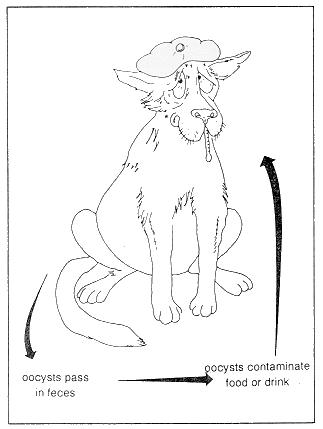| | Life cycle of Isospora spp. | How is coccidiosis recognized? | How is coccidiosis diagnosed? | How can coccidiosis be prevented? | How do I treat infected dogs?
Four species of coccidia (Isospora canis, I. ohioensis, I. neorivolta, and I. burrowsi) are commonly found in dogs. The disease (coccidiosis) caused by these protozoans is commonly diagnosed in puppies under one year of age. Although species of Isospora are found in mature animals, they rarely cause serious problems.
Life Cycle of Isospora spp.

Figure 1. Life Cycle of Isospora
Isospora spp. have developmental stages both within the host animal and outside. The developmental stages within the dog give rise to a microscopic egg (called an oocyst), which is passed in the feces.
Under proper conditions of temperature, moisture, and oxygen, the oocyst develops within three to five days to form a sporulated oocyst capable of infecting other dogs. At this stage, the oocyst contains two sporocysts, each with four bodies (called sporozoites). Each sporozoite is capable of entering cells in the dog's intestine after the oocyst is eaten. When sporozoites enter the cells, they divide many times, producing many offspring. Each offspring in turn may enter other intestinal cells. This cycle may be repeated several times. Because of the rapid multiplication of this stage of the parasite, large numbers of intestinal cells are destroyed.
Eventually, the cycle stops and sex cells (male and female) are produced. The male fertilizes the female to produce an oocyst that ruptures from the intestinal cells and is passed in the feces. Thousands of oocysts may be passed in the feces of an infected animal.
How is Coccidiosis Recognized?
Symptoms of coccidiosis are similar to those seen in puppies with giardiasis. The signs include watery or hemorrhagic diarrhea, dehydration, abdominal tenderness, and anorexia. These symptoms may persist for up to 14 days. Unfortunately, these signs are not specific to coccidiosis only. A veterinarian should be consulted if any of the above signs are seen.
Simply finding oocysts in the feces of a dog does not necessarily indicate the presence of coccidiosis. Many oocysts may pass in the feces, even in dogs that appear clinically normal. However, dogs passing large numbers of oocysts should be treated to reduce environmental contamination.
How is Coccidiosis Diagnosed?
A diagnosis is reached from a combination of clinical signs, physical examination of the animal, and finding Isospora oocysts during microscopic examination of the dog's stools. Oocysts of other coccidia may occasionally be found in the canine feces. These are probably accidental parasites that resulted from dogs eating infected animal carcasses or feces from infected animals. Your veterinarian should be contacted for a positive diagnosis.
How can Coccidiosis be Prevented?
Coccidiosis often results from overcrowded, dirty living conditions. These conditions favor a rapid build-up of oocysts in the dog's environment. The primary concern during coccidiosis outbreaks in kennels is the potential of this disease to spread to other susceptible dogs. Drinking water and feed should be protected from fecal contamination. Infected animals should be isolated from the rest and treated. Removing dogs from contaminated areas interrupts the life cycle of the parasite and helps control the disease.
How do I Treat Infected Dogs?
There are several drugs available to treat coccidiosis. Contact your veterinarian for advice on the most suitable drug and treatment program.
Prepared by:
Dr. Murray Kennedy, Food Safety Division.
Source: Agdex 663-32. Revised April 2001. |
|